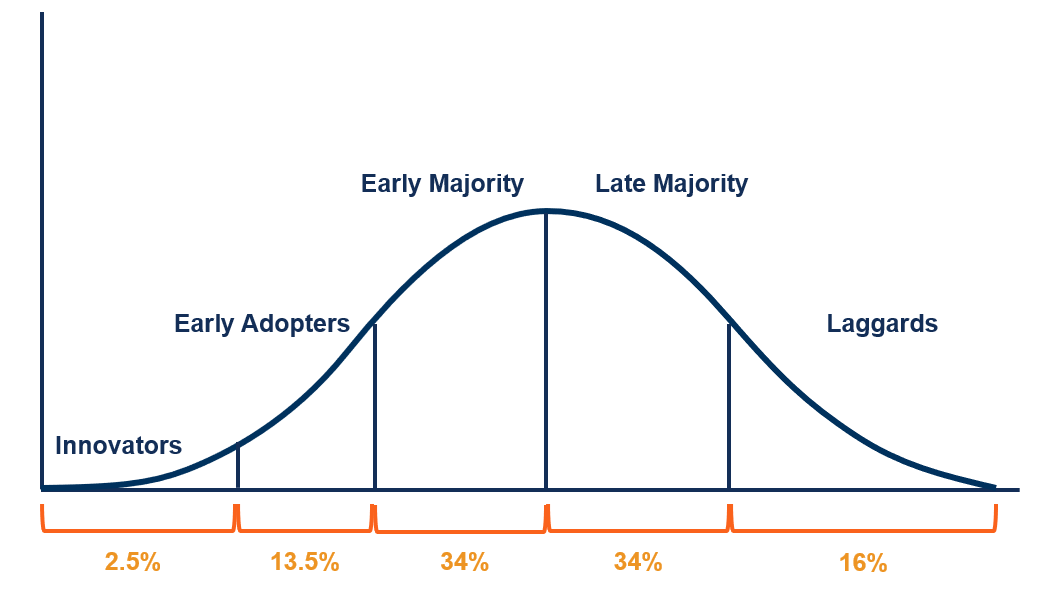What is Diffusion of Innovation?
Diffusion of Innovation (DOI) is a theory popularized by American communication theorist and sociologist, Everett Rogers, in 1962 that aims to explain how, why, and the rate at which a product, service, or process spreads through a population or social system. In other words, the diffusion of innovation explains the rate at which new ideas and technology spread. The diffusion of innovation theory is used extensively by marketers to understand the rate at which consumers are likely to adopt a new product or service.
Rationale Behind the Diffusion of Innovation
The adoption of a new product, service, or idea is not an overnight phenomenon – it does not happen simultaneously across all people in a social system. According to research, consumers who adopt an innovation earlier demonstrate different characteristics than someone who adopts an innovation later. Therefore, for marketers, understanding the characteristics of each segment that will either help or hinder the adoption of an innovation is important.
In the diffusion of innovation theory, there are five adopter categories:
- Innovators: Characterized by those who want to be the first to try the innovation.
- Early Adopters: Characterized by those who are comfortable with change and adopting new ideas.
- Early Majority: Characterized by those who adopt new innovations before the average person. However, evidence is needed that the innovation works before this category will adopt the innovation.
- Late Majority: Characterized by those who are skeptical of change and will only adopt an innovation after it’s been generally accepted and adopted by the majority of the population.
- Laggards: Characterized by those who are very traditional and conservative – they are the last to make the changeover to new technologies. This category is the hardest to appeal to.
Rogers provides the distribution of the five adopter categories as follows: Innovators represent the first 2.5% of the group to adopt an innovation, followed by 13.5% as early adopters, 34% as early majorities, 34% as late majorities, and finally,16% as laggards. Note that the size of the laggards category is much larger than that of the innovators category on the opposite end of the spectrum.

Diffusion of Innovation: Innovators
Innovators are those who want to be the first to acquire a new product or service. They are risk-takers, price-insensitive, and are able to cope with a high degree of uncertainty. Innovators are crucial to the success of any new product or service, as they help it to gain market acceptance.
For example, individuals who stay overnight outside a movie theatre to be the first to purchase the first showing to a movie are considered innovators.
Diffusion of Innovation: Early Adopters
Early adopters are those who are not quite as risk-taking as innovators and typically wait until the product or service receives some reviews before making a purchase. Early adopters are referred to as “influencers” or “opinion leaders”, and are often regarded as role models within their social system. They are key in helping the spread of a product or service achieve “critical mass”.
Therefore, if early adopters of a product or service are small, the total number of people who adopt the product or service will likely be small as well. Individuals who wait a couple of days and spend some time reading reviews before going to see a movie are regarded as early adopters.
Diffusion of Innovation: Early Majority
Early majorities represent the majority of the market – 34%. Early majorities are not risk-taking and typically wait until a product or service is tested or used by a trusted peer. These individuals are prudent and want to purchase things that are proven to work.
Individuals who go to a movie after it’s been out several weeks and gotten good reviews and made profits at the box office are early majorities.
Diffusion of Innovation: Late Majority
Late majorities also represent an important percentage of the market – 34%. Late majorities are the last large group of consumers to enter the market. They are deemed conservative and are often technologically shy, very cost-sensitive, skeptical, and cautious in making a purchase. In addition, late majorities are often peer pressured into purchasing the product or service.
People who wait for a movie to become available online or on Netflix are regarded as late majorities.
Diffusion of Innovation: Laggards
Laggards are the last to adopt a new product or service. They resent change and may continue to rely on traditional products or services until they are no longer available. In other words, they typically only adopt the new technology when virtually forced to.
Laggards perhaps finally catch a hit movie when it’s shown on network TV.
Importance of the Diffusion of Innovation
The diffusion of innovation theory explains the rate at which consumers will adopt a new product or service. Therefore, the theory helps marketers understand how trends occur, and helps companies in assessing the likelihood of success or failure of their new introduction. By utilizing the diffusion of innovation theory, firms can predict which types of consumers will purchase their product/service and create effective marketing strategies to push acceptance through each category.
for more visit
https://corporatefinanceinstitute.com/resources/knowledge/other/diffusion-of-innovation/


No comments:
Post a Comment